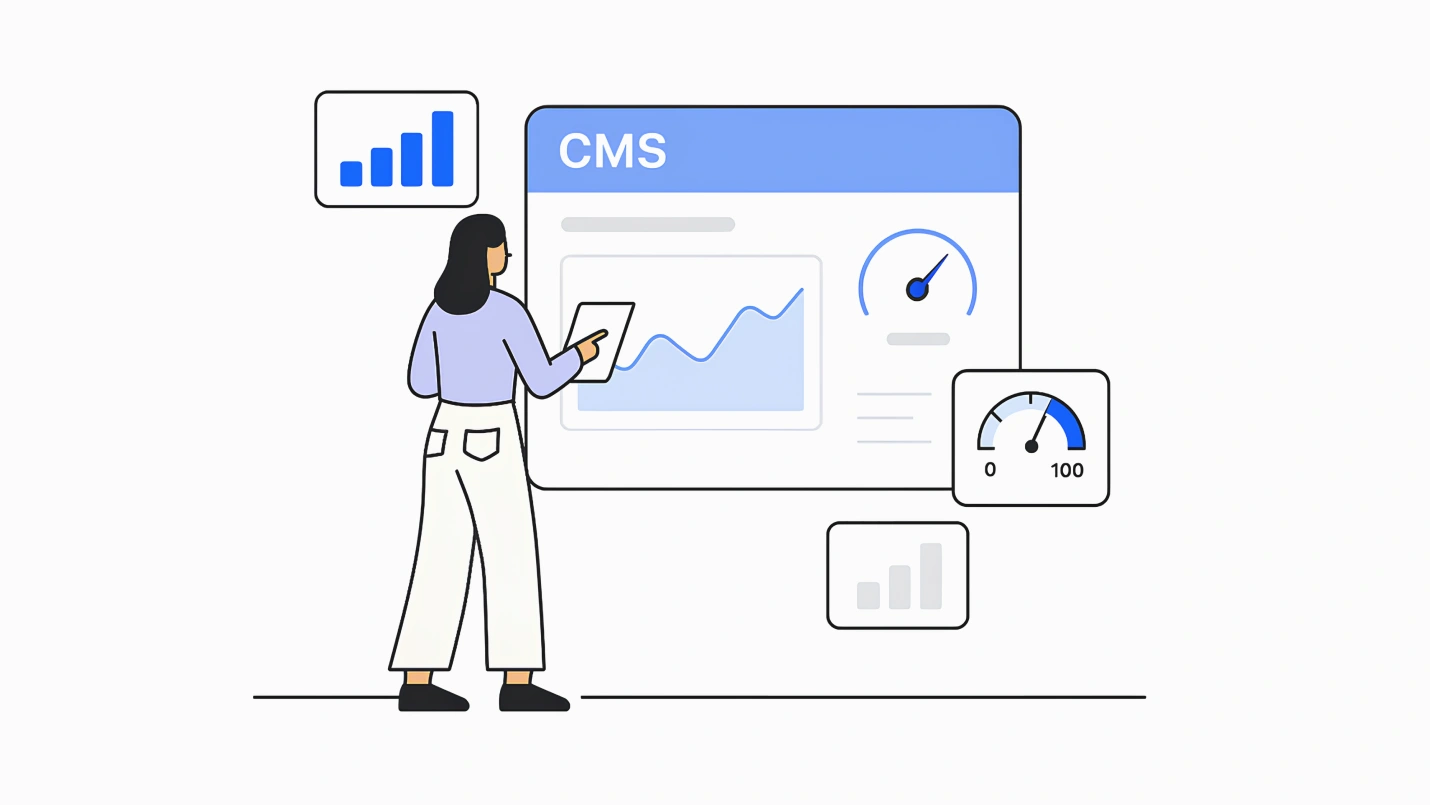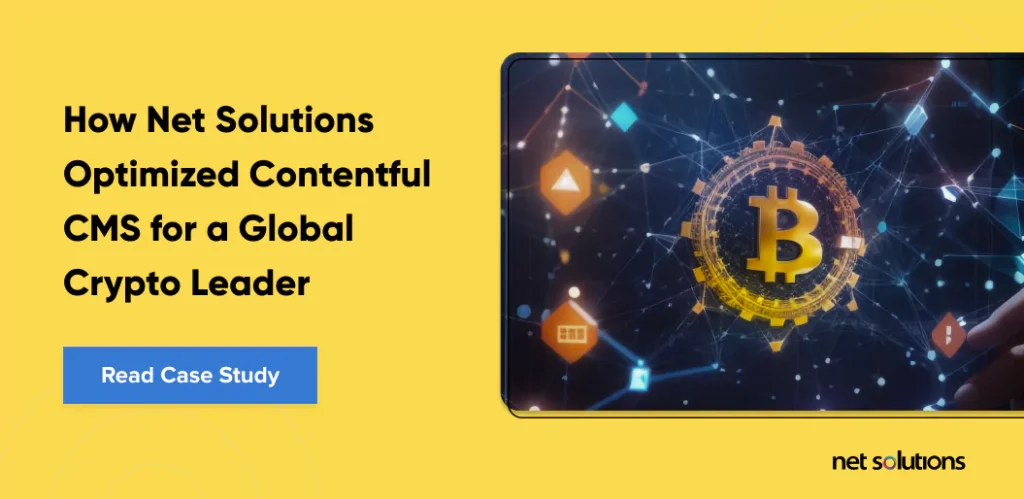Contentful is a powerful headless CMS that helps anyone rapidly create, manage, and distribute content across multiple channels and devices. If you have read our blog post, “What is Contentful,” you would know that the platform’s flexibility and robust APIs make it a go-to choice for many organizations looking to streamline their content operations. However, monitoring key performance indicators (KPIs) to support platform and site performance and ensure content experiences achieve the desired results is critical to maximizing its benefits. We explore 10 essential Contentful KPIs you should monitor and the value of collaborating with a Contentful development services partner to boost your KPI optimization efforts.
We explore 10 essential Contentful KPIs you should monitor and the value of collaborating with a Contentful development services partner to boost your KPI optimization efforts.
Are you new to Contentful? Start with our Guide to Contentful CMS: Features, Benefits, and Best Practices.
10 Key CMS KPIs to Consider while Using Contentful
1. API Response Time
Why It Matters
Faster API response times represent faster site performance, critical for SEO and user experience across interactions.
How to Monitor & Who Can Improve
Tools such as New Relic or Datadog continuously monitor API response times and send out alerts if there are deviations from set benchmarks. Developers can assess their cache strategy, limit payloads, simplify how queries are made, compress responses, and modify REST API responses (among other options).
2. Page Load Speed
Why It Matters
Page load speed refers to the time it takes for a website to load once a user visits fully. Page load directly impacts user experience and is a consideration for page ranking (SEO). Page load speed can be measured in many ways, including Largest Contentful Paint (LCP), which describes the time it takes for the largest content item to load on a page. Google suggests LCP should be below 2.5 seconds.
"Speed and performance are key, especially in news publishing, where we handle large volumes of content daily. We monitor API response times and page load speeds to ensure smooth operations."
Lead Technical Architect, News Agency
How to Monitor & Who Can Improve
Tools such as Page Speed Insights, Lighthouse, GTmetrix, and Core Web Vitals in the Google Search Console (for LCP) will highlight areas that can be improved. Developers and marketers can collectively agree on how many images or multimedia files are included on each page, specifically those above the fold. The sizing of these elements can also be enforced. Using Contentful’s Images API helps ensure files are optimized.
3. Content Delivery Network (CDN) Performance Metrics
Why It Matters
Monitoring CDN performance (via several metrics) ensures that content is served quickly, regardless of user location, and that your CDN meets the standards of your service-level agreement (SLA).
How to Monitor & Who Can Improve
Several metrics can be tracked to assess CDN performance, including latency, cache hit ratio, bandwidth usage, throughput, geographical performance, and error rate. Tools such as Cloudflare or Akamai provide detailed analytics to monitor CDN performance. Developers can optimize the components of their app, alter cache settings, and reduce file sizes to help pages load quickly.
4. Percentage of Processes Automated
Why It Matters
How well you automate tasks can be a measurement of whether you’re using Contentful at its full potential. This includes using Contentful’s Tasks and Workflows apps and new AI tools to accelerate content production and using Contentful’s Functions and third-party tools to automate developer workflows.
How to Monitor & Who Can Improve
To measure the speed of operations, look at the percentage of editorial processes automated using the above apps. You can also track time to market for development.
5. SEO Performance Metrics
Why It Matters
Search engine optimization (SEO) performance impacts how well your content ranks in search engine results, impacting organic traffic and visibility.
How to Monitor & Who Can Improve
Several metrics can be tracked, including search visibility (share of voice), organic traffic, organic conversions, keyword rankings, and backlink quality, using tools like Google Analytics, Lighthouse, or SEMrush. Developers can ensure that content structure and sitemaps are present. Marketers and content creators can ensure that images and content include appropriate metadata. Business owners can choose to upgrade to the Contentful Studio, which uses an AI Content Generator to support content development and SEO.
6. Content Production Efficiency
Why It Matters
Content production efficiency measures how long it takes to move a piece of content from ideation to publishing or distribution. Efficient content production ensures a steady flow of high-quality content, which is essential for maintaining user engagement and meeting business goals.
"Content management efficiency is a key metric—how quickly and easily content creators can add, update, and publish content. We also evaluate how efficiently multilingual content is managed and synchronized across languages."
Chief Marketing Officer, eCommerce
How to Monitor & Who Can Improve
Marketers can use tools like Trello or Asana to track the content pipeline, using built-in reporting tools to spot bottlenecks in the production process. Aside from using project management tools such as Trello or Asana, how developers set up the content model and content types in Contentful can have a direct impact on content production efficiency.
7. User Engagement Metrics
Why It Matters
Once content is produced, user engagement metrics provide insights into how users interact with your content, highlighting what works and what doesn’t. Broadly speaking, you can look at content performance KPIs such as content views, engagement time (time on page), interaction rate, or bounce rate to ensure you’re producing the right content for your audience.
How to Monitor & Who Can Improve
Google Analytics and heatmap tools like Hotjar to better understand user behavior. Marketers have primary responsibility for coming up with and refining content performance, but heat maps may also identify the need to restructure content experience types with the help of developers.
8. Accessibility Metrics
Why It Matters
Addressing accessibility not only makes web design more user-friendly, especially for those with disabilities, it often boosts usability and user experience for all users. Accessibility is also a critical factor in SEO rankings.
How to Monitor & Who Can Improve
The accessibility error rate tracks the number of errors on your website or app. In contrast, the accessibility score indicates how well you meet the Web Content Accessibility Guidelines (WCAG), with a goal minimum of 80%. Your Contentful content model is your first step in accessibility and provides a content-agnostic base to allow editors to manage voice content on the web. Tools to audit accessibility include accessiBe and Level Access.
9. Localization and Personalization Effectiveness
Why It Matters
Localized and personalized content caters to diverse audiences with specific needs and wants, helping to enhance user relevance and engagement, accelerate the customer journey, and increase customer loyalty.
How to Monitor & Who Can Improve
Track metrics such as engagement rates by region and language-specific traffic for localized content. For personalized content, follow the User Engagement metrics discussed in step 7, with the addition of ‘conversion’ for any eCommerce scenario. Developers and marketers collaborate to choose an appropriate personalization engine, set up locales, and increase efficiency in working with translators.
Ready to explore pricing options for implementing Contentful?
Read More10. Return on Investment (ROI)
Why It Matters
There are many reasons to start or replatform with Contentful, so your ROI should be measured against those: optimizing development or content editor productivity, a desire to use new technology, expansion in channel reach, scaling, or user engagement or revenue goals.
“Conversion rate optimization (CRO) is at the forefront of many organizations' strategies. Contentful can drive substantial revenue growth when integrated with CRO frameworks. A simple A/B test can result in significant revenue gains by identifying the optimal placement of a call-to-action button. The crawl-walk-run approach adopted by some organizations exemplifies the gradual implementation strategy—starting with foundational changes, scaling efforts as results materialize, and eventually reaching complete optimization. This method ensures that companies realize the full potential of Contentful without overwhelming their teams with abrupt transitions.”
Chief Marketing Officer, Multi-Media
How to Monitor & Who Can Improve
ROI measurement is contingent on the goals and may include many KPIs, including revenue or cost savings. Tools like Google Analytics and financial tracking software can assist in this analysis, as well as third-party tools for specific ROI goals, e.g., using Kissmetrics to track marketing success across channels. Everyone who uses Contentful has a hand in contributing to ROI in some way.
Partnering with a Contentful Development Services Partner
While monitoring KPIs is crucial, many organizations struggle with KPI overload: not knowing which KPI to track, how to interpret tool insights, and what steps to take to achieve and maintain optimal performance. As this post has demonstrated, even the “top KPIs” to track can include variability. Bringing in an experienced partner can help accelerate your Contentful optimization efforts.
Partnering with a certified Contentful partner can provide the necessary support and insights to help you meet your goals effectively:
- Expert Guidance and Consultation tailored to your specific needs and business goals. An experienced partner can help set up KPI tracking, identify performance bottlenecks, recommend best practices, and provide strategic insights to enhance your Contentful implementation.
- Custom Development and Integration using experienced Contentful developers who can assist with the custom development of bespoke solutions, seamless integration with existing systems and third-party solutions, and expert replatforming services.
- Training and Support from a Contentful partner ensure that your team remains proficient in using the platform and that all content types are set up optimally to support site performance and engagement KPIs.
- Performance Optimization to ensure Contentful is set up with the ideal content model and integrations, as well as fine-tuning API queries, implementing advanced caching strategies, and ensuring efficient content delivery through CDNs.
- Continuous Improvement and partnership to monitor key KPIs, provide regular performance reports and suggest ongoing enhancements to align your content strategy and tech stack with evolving business goals.
Case Study: Net Solutions Helps Crypto Firm Optimize Contentful CMS
We recently worked with a client who struggled with one of the most common hurdles to optimizing many KPIs in Contentful: an improperly structured data model. The client experienced a drain on developer resources, low content production efficiency, and even issues with page load speed—all of which reduced their overall ROI. With an in-depth analysis of site performance, client needs, and opportunities, the partnership helped boost KPIs across the board. Continue reading our case study to see how we helped our client realize the full potential of Contentful.
Monitoring these KPIs across your Contentful implementation helps ensure optimal site performance and strategic alignment with business goals. Collaborating with a contentful development services partner such as Net Solutions can further amplify these efforts by providing expert guidance, custom solutions, and ongoing support.
A partnership with Net Solutions can help you maximize Contentful’s capabilities, drive better results, and achieve long-term success.
New to Contentful? Start with our Guide to Contentful CMS: Features, Benefits and Best Practices.





